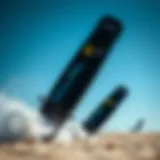Discover Wingfoiling: Gear, Techniques, and Culture
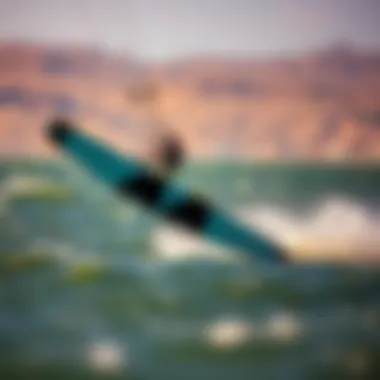

Intro
As the sun graces the horizon, revealing its warm rays upon the glistening water, a new breed of enthusiast takes flight above the waves. Wingfoiling, merging elements of kiteboarding, windsurfing, and surfing, is not just another passing fancy in the water sports realm; it embodies a unique culture and community that thrives on shared passion and adventure. This article embarks on a deep dive into the intricate components of wingfoiling—from the essential gear that makes the ride possible to the techniques that set practitioners apart on the waves.
The intricate dance between wind, water, and rider produces a spectacular show. Whether you’re a newcomer eager to catch your first gust or an experienced rider honing advanced maneuvers, understanding the fundamentals is crucial. But there's more—gear selection, proper maintenance, and the community that binds riders collectively enrich the experience of wingfoiling.
%%%
"Wingfoiling is not merely a sport; it's a way of life that bridges the gap between nature and adrenaline." %%%
Through structured sections, we’ll explore gear and equipment essential for both beginners and seasoned veterans. We'll delve into basic and advanced techniques, highlight safety measures, and touch on the vibrant culture that surrounds this exciting sport. Ultimately, this comprehensive guide serves anyone looking to immerse themselves in the thrilling world of wingfoiling.
Now, let’s set sail into the first course of our journey—gear and equipment.
Intro to Wingfoiling
Wingfoiling has quickly woven itself into the expansive tapestry of water sports, capturing the hearts of thrill-seekers and adventure lovers alike. By merging elements of kiteboarding, windsurfing, and surfing, this innovative activity offers a unique experience that is both exhilarating and serene. Understanding the foundations of wingfoiling is crucial for anyone looking to dive into its depths, as it combines technique, gear, and an appreciating culture that makes the sport appealing.
Definition and Overview
At its core, wingfoiling is a water sport where a rider uses a handheld wing to harness wind power while gliding above the water on a hydrofoil board. Unlike traditional windsurfing, the wing is not attached to the board, allowing for greater freedom of movement. This sport is particularly appealing because it allows riders to catch waves, navigate flat water, and perform tricks, all while being elevated above the surface, minimizing drag and enhancing speed.
To get started, riders must develop a strong understanding of how to control the wing and balance on the board. The thrill of wingfoiling lies in the fluidity of the experience; as riders learn to manipulate the wind and water, they can transition from gliding effortlessly to executing advanced maneuvers. Given its rising popularity, it’s not uncommon to see groups of wingfoilers gathering at local beaches—each reveling in the unique camaraderie that comes with sharing this exhilarating passion.
Historical Context
The evolution of wingfoiling is both fascinating and a testament to the human drive for innovation in sports. Although the exact origins are somewhat murky, wingfoiling's concept draws from the principles of kiteboarding and windsurfing. The first known instances of similar techniques were explored as far back as the 1990s, when experimental boards were made with foils to achieve lift.
However, it wasn't until recent technological advancements—particularly in wing design and hydrofoil construction—that wingfoiling gained serious traction. The lightweight materials and improved aerodynamics have allowed enthusiasts to push boundaries like never before. Now, spots around the world, from the gentle breezes of the Caribbean to the strong winds of Hawaii, serve as playgrounds for those eager to embrace the thrill of this sport.
"The simplicity and connection to nature offered in wingfoiling attract many water sports enthusiasts; it’s about riding the wind and water in harmony."
Thus, as its history unfolds, wingfoiling promises to keep evolving, influenced by advances in gear technology and the passion of its growing community. Understanding where this sport comes from not only enriches the experience but also helps participants appreciate the fusion of artistry and athleticism that defines it.
The Gear Required for Wingfoiling
Understanding the gear required for wingfoiling isn’t just about knowing what to buy. It's essential for ensuring a safe and enjoyable experience on the water. With proper equipment, both newcomers and seasoned participants can enhance their performance and navigate through different levels of difficulty. The right gear contributes significantly to how effectively one learns and masters techniques while also enjoying the thrill that wingfoiling offers.
Wings: Types and Specifications
When it comes to wings, there’s more than meets the eye. The wing you choose will profoundly impact your riding experience and performance. They come in various sizes, shapes, and materials, tailored to respond to different wind conditions and user preferences.
- Size Variations: Wings are generally categorized by their surface area, which influences the amount of lift they generate. Smaller wings are fitting for strong winds, while larger wings suit lighter winds. Flying a larger wing in powerful gales can feel like trying to tame a wild stallion.
- Shapes and Designs: Each wing shape alters flight characteristics. For instance, some are built for easy maneuverability, which is perfect for beginners. In contrast, others are tailored for high-speed sessions and tricks, suitable for more experienced riders.
- Materials Used: Durability is key. Most modern wings are constructed from ripstop nylon and other resilient materials that withstand punctures and tears. Some brands are even experimenting with lighter composites to boost performance.
Ultimately, selecting the right wing boils down to understanding the wind and your proficiency. Some enthusiasts even swear by having a variety of wings at their disposal, adapting to whatever nature throws their way.
Foils: Understanding the Mechanics
Foils are the heart and soul of wingfoiling. Their intricate engineering allows riders to glide above water with an almost ethereal grace. The mechanics might sound complex, but grasping the fundamentals can significantly improve one’s skill on the water.
- How They Work: Foils operate on the principle of lift and drag. As water flows over the wing-shaped structure submerged beneath the board, pressure changes create lift that raises the rider above the surface. This enables a smooth sail through water, often described as feeling akin to flying.
- Different Types of Foils: Just like wings, foils come in various configurations, including high-aspect and low-aspect designs. High-aspect foils are ideal for speed, while low-aspect models offer better maneuverability, making them more suited for casual cruising or novice users.
- Compatibility: Ensure that the foil you choose matches your board and wing setups. For instance, a larger board might require a different foil to maintain balance and stability. Mismatched gear can turn a fun experience into an exercise in frustration.
Understanding foils opens a gateway to more advanced techniques and variations in ride styles. It's worth investing time to learn about their specific nuances to improve overall performance.
Boards: Choices and Characteristics
Selecting the right board is pivotal in wingfoiling. Boards vary significantly in dimensions, volume, and shape. These factors determine how well they perform under different conditions and user styles.
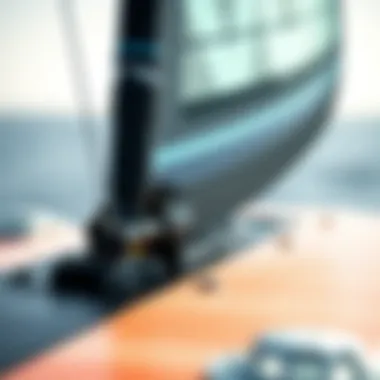

- Types of Boards: There are predominantly two types—all-around boards and specialty boards. All-around boards are versatile traits that suit both beginners and experts, providing a nice balance for varied conditions. Specialty boards, on the other hand, target specific riding styles, like freestyle or racing.
- Volume Considerations: An important aspect is the board's volume, which affects buoyancy. A higher volume board offers more stability and is easier for novices. However, experienced riders might prefer lower volume boards for agility and speed, akin to riding a sports car versus a family SUV.
- Material Choices: Boards are made from various materials, including foam and composite. Lightweight boards made from materials such as carbon fiber can give seasoned riders advantages like better response time. However, these can be pricier compared to more conventional options.
Ultimately, the board should resonate with the rider’s skills, aspirations, and preferences, shaping the entire wingfoiling experience.
Select your gear wisely; it will define your journey through the exhilarating realms of wingfoiling.
In summary, the gear for wingfoiling encompasses wings, foils, and boards, each influencing performance, safety, and enjoyment. This careful selection and understanding of equipment not only ensure an enjoyable ride but also help in mastering the various techniques intrinsic to the sport. To get further insights, one could explore forums on Reddit or check out industry discussions on websites like kitesurfing.com for recommendations from fellow enthusiasts.
Mastering Wingfoiling: Techniques and Skills
Mastering wingfoiling is not merely about getting from point A to point B on the water; it’s a blend of finesse, balance, and understanding the elements around you. For anyone looking to delve into this exhilarating sport, developing the right techniques is absolutely crucial. It can significantly enhance your enjoyment, boost confidence, and ensure safety. This section will explore the key techniques across various skill levels, allowing you to progress steadily and confidently.
Basic Techniques for Beginners
Starting with the basics, it’s vital to grasp a few foundational techniques that ensure a solid footing in wingfoiling.
- Stance and Balance: Your stance sets the stage. Begin with your feet shoulder-width apart, either centered or slightly back on the board. Ensuring proper balance helps maintain control, especially in choppy waters.
- Launching the Wing: Grasp the handles firmly and elevate the wing above your head. The right wind direction is key; aim for it to fill the wing evenly. Take a few moments to feel the pressure in the wing—it’ll help you to understand the pulling force as you start gliding.
- Getting Up on the Board: With the wing steady and the wind pulling, use your legs to push down while gently pulling the wing towards you. It’s a dance with the wind—a little push here, a little pull there. Feeling the lift underfoot is the moment every beginner looks forward to.
- Basic Riding: Once on the board, look ahead to maintain your balance and steer by shifting your weight. Keep your knees slightly bent, stay relaxed, and let the wing do the work.
These core skills form the bedrock for more advanced maneuvers later on.
Intermediate Maneuvers
Once you've nailed the basics, it’s time to push the envelope a bit further. Intermediate maneuvers challenge your skills while amplifying the thrill of wingfoiling.
- Tacking and Gybing: Turning gracefully on the water can feel like ballet on a board. Tacking involves turning upwind, while gybing is for downwind. Focus on shifting your weight and keeping your body low to smooth the transitions.
- Using the Foil: Learning to ride the foil can open a treasure trove of new experiences. Feel the lift as you increase your speed and rise above the water surface. Weight distribution is key; leaning too far forward or back can lead to nosedives or losing lift.
- Unhooking Techniques: Once you get comfortable, try unhooking from the wing for a short time, allowing for greater movement. This requires confidence, so practice in safe environments. Use caution as the wind can be unpredictable in these moments.
These intermediate skills bring more fun and excitement, setting you up for expert-level tricks.
Advanced Tricks and Skills
At last, the moment you’ve been waiting for—the sword dance of wingfoiling techniques! Mastering advanced tricks takes not just skill, but also creativity and a tad of daring.
- Jumping: With enough speed and confidence, approach a small wave or chop. Bend your knees, lean back, and use the wing’s lift to propel yourself into the air. Timing and takeoff angle are crucial here.
- Spins and Flip Tricks: For those with a flair for the dramatic, spinning your board mid-air or performing a flip can be immensely satisfying. As you spin, your focus should be on landing; a perfect landing will elevate your confidence.
- Transitions: Quick transitions from one maneuver to another while in motion are the hallmark of a skilled practitioner. This craft requires impeccable timing and awareness of your surroundings to avoid any mishaps.
Learning lead-ups and follow-throughs for each trick builds your capabilities incrementally. Remember, even the pros had their own share of spills!
Stepping through these stages at your own pace is essential. Underlying them all is a commitment to practice and patience—a mantra that resonates deeply within the wingfoiling community. Progressing through basic, intermediate, and advanced techniques adds layers of depth to your wingfoiling experience.
For further education and community involvement, consider visiting resources like Wikipedia's Wingfoiling Page or exploring discussions on Reddit's Wingfoiling to connect with fellow enthusiasts.
Safety Considerations in Wingfoiling
In the exhilarating pursuit of wingfoiling, safety stands as the cornerstone to not just enjoying the sport, but also ensuring longevity in practice. It is crucial to grasp various safety measures, which not only safeguard the participant but also raise awareness regarding the environment where this sport thrives. From understanding the wind and water conditions to making certain that gear is properly checked before hitting the waves, a sound approach to safety can make all the difference between a thrilling day on the water and a harrowing experience. The following sections break down the essential components of safety that every aspiring wingfoiler should consider.
Understanding Weather Conditions
Knowledge of weather patterns is indispensable for anyone involved in wingfoiling. The ocean is an unpredictable wilderness, where sudden shifts in wind and water can catch even the most seasoned riders off guard. Before deciding to take to the water, consider the following:
- Wind Speed and Direction: Check local wind forecasts. A beginner might find comfort in steady winds between 10 and 20 knots, avoiding gusty or unpredictable conditions.
- Tides and Currents: Understanding tide schedules can impact your experience significantly. Low tide might expose shallow obstacles, while currents can carry you far from your starting point if you aren’t wary.
- Weather Systems: Familiarize yourself with storm signs. A darkening sky or sudden drops in temperature can signal an oncoming front, prompting a swift exit from the water.
"Knowledge of weather is just as essential as mastering technique. Your safety hinges on it."
Equipment Safety Checks
Before launching into the waves, conducting thorough equipment checks can save you from potential mishaps. The reputation of wingfoiling as a fun and adventurous sport often belies the need for meticulous gear preparation. Here’s a checklist to consider:
- Inspect the Wing: Examine the canopy for any tears or punctures. Ensure the strut is fully inflated and that the seams are intact.
- Foil Integrity: Check the mast and wings for any signs of wear. A flexible or cracked foil can lead to serious accidents.
- Board Condition: Look for any signs of delamination or cracks on the board. Make sure the foot straps are securely attached, allowing you to maintain control.
Personal Safety Practices
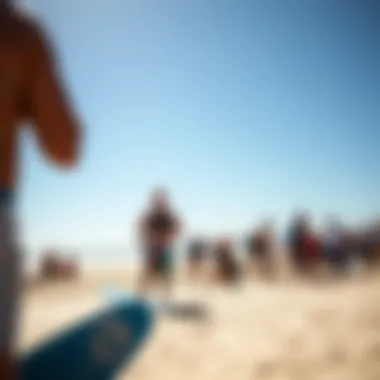

Personal safety practices play an elongated role in ensuring a safe and enjoyable wingfoiling experience. Adhering to these practices ultimately cultivates a safer community on the water. Here’s what to keep in mind:
- Wear a Proper Life Vest: A buoyancy aid tailored for water sports should always be part of your kit. It can provide immediate support in case of unexpected falls.
- Use a Leash: Attaching your wing to the board with a leash not only prevents loss of equipment but can also prevent injury from a loose wing striking you.
- Buddy System: Whenever possible, wingfoil with a partner. Should an issue arise, having someone around can make all the difference.
- Know Your Limits: It’s tempting to push your limits, but recognizing when conditions are too challenging is vital. Always be aware of your own skill level and the environment.
By embracing these safety considerations, you not only protect yourself but also contribute to the collective awareness of the community. Safety doesn’t need to be sacrificed for thrill; rather, it can heighten it. Every wingfoiler, regardless of skill level, should prioritize these considerations to truly enjoy the freedom that comes with the sport.
Exploring Destinations for Wingfoiling
Wingfoiling is not just a thrilling sport; it’s also a journey into some of the world’s most breathtaking locations. Choosing the right destination can significantly enhance the wingfoiling experience, as the interplay between wind, water, and landscape creates an unforgettable backdrop for both learning and performance. This section delves into the key aspects of selecting destinations, the varying benefits they offer, and what considerations are vital for wingfoilers when planning their next adventure.
Top Locations Worldwide
When it comes to wingfoiling, some places are like the holy grail for enthusiasts. They promise steady winds, perfect waves, and picturesque settings. Not all beaches are created equal, however. Here are a few standout locations worth considering:
- Hood River, Oregon: Known as the wind sports capital of the U.S., Hood River boasts a steady wind profile and diverse conditions that cater to both beginners and pros. The Columbia River Gorge offers stunning views and a community that’s passionate about water sports.
- Maui, Hawaii: Considered one of the meccas of water sports, Maui provides consistent trade winds coupled with various options for flat water as well as waves. While it might be more on the pricey side, the stunning landscape and vibrant surfing culture make it worthwhile.
- South Padre Island, Texas: Here, you get a blend of beautiful beaches and favorable wind conditions. Attractions include warm weather year-round, making it a prime spot especially during the winter.
- Cascais, Portugal: This coastal town offers a charming atmosphere, alongside great wind conditions. With multiple spots for different skill levels, it has become increasingly popular among wingfoilers over the years.
Each of these locations has its own charm and specific conditions that can greatly affect performance. Whether you’re looking to practice new tricks or simply enjoy a fun day on the water, picking the right spot makes a world of difference.
Hidden Gems for Enthusiasts
While well-known spots often steal the spotlight, there are countless hidden gems that can provide just as exhilarating wingfoiling experiences—sometimes even more so. Here are a few lesser-known destinations that hold significant potential:
- Cabarete, Dominican Republic: A small kiteboarding haven, Cabarete offers reliable winds and an inviting atmosphere. It's less crowded than some other spots, allowing for a more personalized experience, especially for those wanting to practice their skills.
- El Yaque, Venezuela: This beach is frequently cited as one of the best for wind sports, featuring shallow, warm waters and consistent winds. Despite its fame, it still remains a bit under the radar, which can lead to more space on the water.
- Isla Blanca, Mexico: Tucked away from the more commercial tourist areas, Isla Blanca features flat, shallow waters and regular wind, perfect for those keen on honing their techniques without the pressure of large crowds.
- Dakhla, Western Sahara: An increasingly popular destination for adventurous spirits, Dakhla offers stunning natural landscapes and consistent winds. The lagoon is flat, making it ideal for beginners and advanced riders alike.
Finding these undiscovered spots often requires a bit of research and a willingness to venture off the beaten path. However, the rewards are plentiful and can lead to memorable sessions away from the hustle of popular beaches.
The Community and Culture of Wingfoiling
The community and culture surrounding wingfoiling play a significant role in shaping the experience of participants and the growth of the sport itself. This is not just about individuals riding the wind and waves; it’s about a shared connection that links enthusiasts from all walks of life. The friendships forged and the camaraderie developed create a rich environment that enhances both personal enjoyment and the overall cultivation of wingfoiling. With events and local meetups, the culture nurtures a sense of belonging while promoting the sport to a broader audience.
Connecting with Other Enthusiasts
Finding fellow wingfoilers can elevate the experience from solitary practice to a vibrant community action. Many enthusiasts start their journey alone, but as they learn the ropes, they quickly discover resources like online forums, local clubs, and social media groups that foster connections with other enthusiasts. These spaces serve as virtual meeting points where individuals share tips, organize outings, and even offer gear recommendations.
- Social Media Groups: Platforms like Facebook and Reddit host groups solely for wingfoiling where novices can ask questions and veterans can share insights.
- Meetup Groups: Organizing or participating in local meetups can lead to long-lasting friendships as participants share their learning experiences, challenges, and special tricks they’ve picked up.
- Workshops and Clinics: Many independent instructors offer workshops that not only focus on skill enhancement but also emphasize the community aspect, allowing bonding through shared experiences.
With this nurturing environment, aspiring wingfoilers glean valuable information while fostering a supportive network that enhances their journey.
Events and Competitions
Events and competitions are central to the culture of wingfoiling, offering enthusiasts a chance to showcase their skills and connect with the global community. These gatherings can range from informal meetups at local spots to international competitions that bring together the best in the sport.
- Local Competitions: These are often organized by nearby clubs or schools, serving as perfect platforms for learners to compete and pick up tricks from seasoned riders. They also nurture a spirit of friendly rivalry that can motivate participants to improve.
- Regional Events: Bigger events often include fun activities alongside competitions, such as BBQs, bonfires, or music, creating a festive atmosphere and making wingfoiling approachable to spectators.
- International Competitions: These are major highlights in the wingfoiling calendar, attracting elite riders and enthusiasts from all corners of the world. It’s during these events that spectators can witness cutting-edge maneuvers and talk to top athletes about their techniques and equipment.
Participating in or attending events bolsters the community's collective spirit and further enhances the visibility of wingfoiling. Events not only serve as competitions, but also as celebrations of a culture that thrives on innovation, passion, and mutual respect among enthusiasts.
"Our community is like a wave; it grows strong as we come together, riding the tide of growth and adventure in wingfoiling."
As the world of wingfoiling continues to expand, its community remains an essential component that fosters connections and showcases the diverse experiences that enrich this exhilarating sport.
Evolving Trends in Wingfoiling
The world of wingfoiling is constantly shifting and evolving. Understanding these trends not only helps enthusiasts keep pace but also allows them to appreciate how this sport integrates into broader water sports culture. The relevance of exploring evolving trends lies in their potential to enhance performance, accessibility, and sustainability in wingfoiling.
Innovations in Gear Technology
One of the most significant aspects of the evolution of wingfoiling is the rapid advancements in gear technology. New materials and engineering techniques have dramatically changed the designs of wings, foils, and boards.
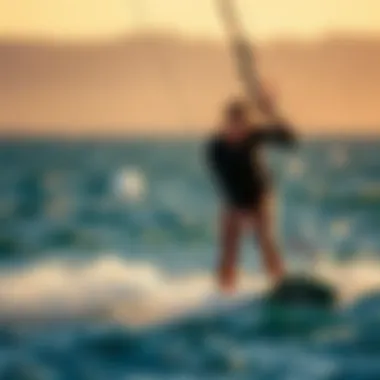

- Materials: The shift from heavier materials to lighter, high-strength composites allows for easier handling and improved performance on the water. For instance, wings are now often made from ripstop nylon or mylar, which contribute to durability without sacrificing weight.
- Board Design: Streamlined boards with improved shapes enable better hydrodynamic efficiency. Manufacturers are producing boards that suit diverse styles, whether it be for speed, freestyle tricks, or long-distance cruising.
- Foil Technology: Foils are evolving to offer increased lift and stability at lower speeds. Some models now integrate adjustable wing shapes that allow riders to customize their experience for different conditions.
This constant innovation bears significance not only for performance but also for making the sport more accessible. As gear becomes easier to use, more newcomers can participate, expanding the community and strengthening its culture.
Changing Demographics of Participants
The demographic landscape of wingfoiling is experiencing a noticeable shift. Initially dominated by seasoned water sports enthusiasts, the sport is now attracting a broader audience.
- Age Range: Young adults are increasingly drawn to wingfoiling, with many in their 20s and 30s finding an appealing alternative to traditional water sports. Additionally, the sport has begun to attract families, as setups for kids become more available.
- Gender Participation: There is also a gradual increase in female participation. Special courses and community events aimed specifically at women are helping to foster a more inclusive environment.
- Access to Equipment: The rise of rental facilities and schools worldwide has lowered barriers to entry for newcomers. Many establishments offer lessons tailored to different skill levels, allowing beginners to get into the sport without the hefty investment in gear right off the bat.
The evolving demographics signify a richer tapestry of personalities and experiences within the sport. It fosters community bonding, as varying perspectives contribute to the understanding and appreciation of the wingfoiling culture.
"As wingfoiling grows, the community becomes not just a group of hobbyists, but a vibrant culture with diverse voices shaping its future."
In summary, staying informed about the evolving trends in wingfoiling sheds light on how technology and changing demographics are shaping the sport. This understanding is crucial for those looking to improve their skills and for companies aiming to serve this dynamic community.
Environmental Considerations
Wingfoiling has rapidly gained traction as a thrilling water sport, but like any outdoor activity, it carries environmental implications that merit attention. Protecting our natural surroundings is not just a responsibility; it’s crucial for the longevity of the sport. Understanding and implementing environmentally friendly practices is essential to ensure that our oceans and waterways remain pristine for both current and future enthusiasts.
Sustainable Practices in Wingfoiling
Sustainability in wingfoiling involves several angles, from gear manufacturing to responsible usage during sessions on the water. The importance of integrating sustainable practices cannot be overstated. Here are key elements to consider:
- Eco-friendly Equipment: More manufacturers are turning to sustainable materials when producing wings, boards, and foils. Choices such as recycled plastics and organic fibers help cut down on waste.
- Local Knowledge: Engaging with local communities and understanding the environment where you practice can enhance respect for those ecosystems. This may involve adhering to local regulations or avoiding sensitive areas during nesting seasons of wildlife.
- Education and Advocacy: As enthusiasts, advocating for marine conservation and educating peers about the impacts of pollution and climate change can foster a collective approach to sustainability.
Implementing these practices can significantly minimize the sport’s footprint while still delivering the adrenaline rush that wingfoilers seek. Like the old saying goes, we don’t inherit the earth from our ancestors; we borrow it from our children.
Impact on Marine Ecosystems
The relationship between wingfoiling and marine ecosystems is complex, often requiring careful navigation. While wingfoiling can be low in impact compared to other water sports like power boating, it still has the potential to disturb delicate habitats. Key considerations include:
- Habitat Disruption: Foiling affects the surface of the water and can disturb marine animals such as fish and seals, particularly in sensitive breeding or feeding grounds.
- Pollution and Trash: The presence of trash not only alters iconic landscapes but directly harms wildlife. A conscientious approach includes packing out what you bring in, and even participating in local clean-up efforts.
- Water Quality: Wingfoiling in polluted waters may harm both riders and marine life. Testing water quality before entering can prevent exposure to contaminants.
Proper stewardship is the key to maintaining the delicate balance between sport and nature. By taking these steps seriously, wingfoilers can enjoy their passion while actively contributing to the protection of the environment.
Culmination
Understanding how our actions on the water affect the environment is paramount to enjoying the sport sustainably. By adopting best practices and staying informed, every player in the wingfoiling community can ensure the sport thrives for generations to come.
Future Prospects of Wingfoiling
The future of wingfoiling holds exciting potential and offers a wealth of opportunities for those interested in this captivating sport. Understanding these prospects is essential for anyone involved in or contemplating diving into the world of wingfoiling. As the sport continues to gain traction, the implications for growth, technological advancements, and even environmental sustainability become more pronounced.
Potential Growth of the Sport
The surge in popularity of wingfoiling can be attributed to several factors that have culminated in a growing community. To begin with, it has a relatively low barrier to entry compared to other water sports like kiteboarding or windsurfing. This means that more people can jump in without needing extensive prior experience or access to specialized locations.
Additionally, the thrill of gliding over water, combined with the uniqueness of the wing, is attracting a diverse range of enthusiasts—from beginners to seasoned veterans. The demographic landscape is evolving.
- Many outdoor enthusiasts, especially younger generations, are eager to explore sports that combine adventure and freedom.
- The increasing availability of wings, foils, and boards tailored for various skill levels caters to the trend toward versatile equipment.
These aspects contribute to a community that is not just expanding in numbers but also becoming interconnected. Online forums like Reddit and social media platforms provide spaces for enthusiasts to share experiences, tips, and advice, further fueling interest and participation.
Technological Advancements on the Horizon
Innovation remains a crucial element shaping the future of wingfoiling. Manufacturers are constantly refining gear to enhance performance and accessibility. Below are some noteworthy advancements that we can look forward to:
- Materials Improvements: New lightweight and durable materials are being designed for wings and boards, leading to better performance while minimizing fatigue.
- Foil Design: Advances in hydrofoil technology can lead to more efficient designs that allow riders to experience smoother glides and improve speed.
- Smart Gear: The introduction of technology into equipment—like performance trackers and integrated GPS—can provide real-time feedback, helping users to refine their techniques.
“As gear becomes more sophisticated, even beginners can achieve what once seemed unattainable levels of performance.”
Ultimately, these technological enhancements promise to not only elevate the sport's performance but also make it a more engaging experience for participants.
In summary, the future of wingfoiling looks vibrant. With an increasing number of enthusiasts looking to learn, practice, and push the boundaries of this sport, the environment seems ripe for growth. The ongoing innovations in gear and technique will enrich the overall experience, leaving plenty for both the novice and the expert to look forward to. For more insights on wingfoiling's impact and advancements, visit resources like Wikipedia and Britannica.


